From Mobile Network to 4G: An Analysis of Technological Development
VerifiedAdded on 2023/06/10
|30
|8214
|139
Report
AI Summary
This report provides an in-depth analysis of the technological and evolutionary development of mobile networks, focusing on the transition to 4G technology. It highlights the advancements from earlier generations, emphasizing the improved data speeds, enhanced modulation techniques, and the flexibility of multimedia communication offered by 4G. The report discusses key technologies such as OFDM, smart antennas, and VoLTE, while also addressing the challenges and requirements for deploying 4G networks, including compatibility concerns and capital investment. Furthermore, it traces the evolutionary path from 1G to 4G, outlining the significant changes and innovations in each generation. The study concludes by considering the future prospects and potential concerns associated with the ongoing development of mobile network technology.
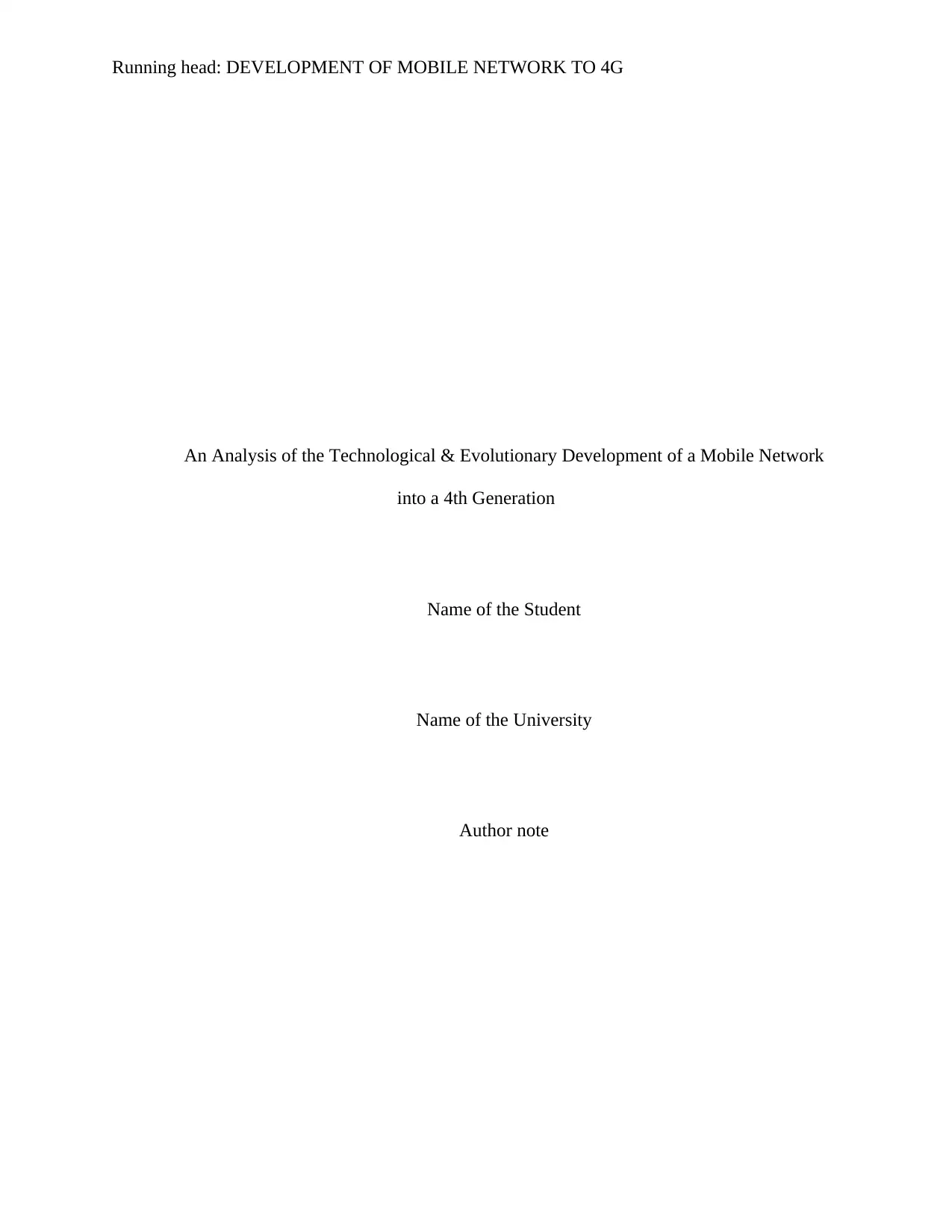
Running head: DEVELOPMENT OF MOBILE NETWORK TO 4G
An Analysis of the Technological & Evolutionary Development of a Mobile Network
into a 4th Generation
Name of the Student
Name of the University
Author note
An Analysis of the Technological & Evolutionary Development of a Mobile Network
into a 4th Generation
Name of the Student
Name of the University
Author note
Paraphrase This Document
Need a fresh take? Get an instant paraphrase of this document with our AI Paraphraser
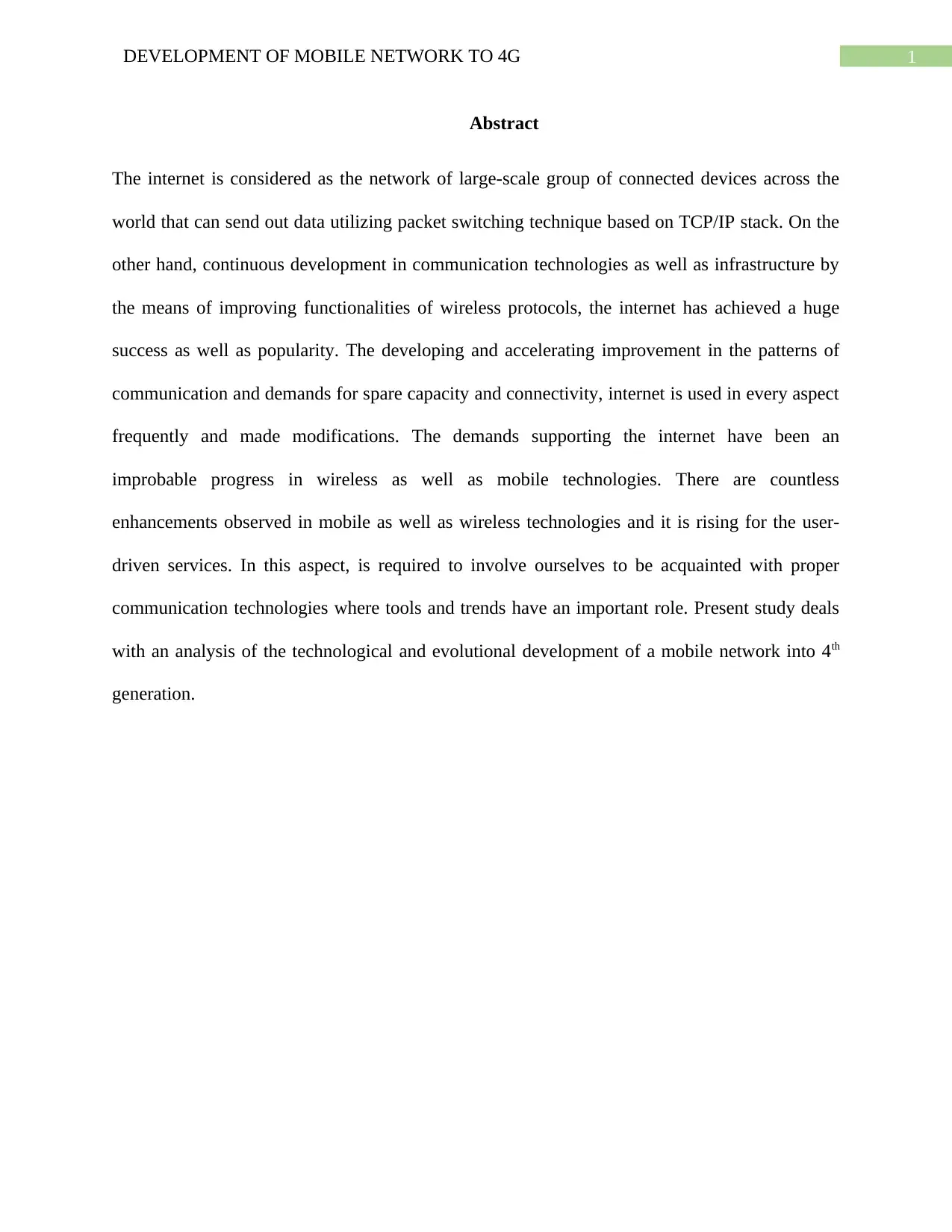
1DEVELOPMENT OF MOBILE NETWORK TO 4G
Abstract
The internet is considered as the network of large-scale group of connected devices across the
world that can send out data utilizing packet switching technique based on TCP/IP stack. On the
other hand, continuous development in communication technologies as well as infrastructure by
the means of improving functionalities of wireless protocols, the internet has achieved a huge
success as well as popularity. The developing and accelerating improvement in the patterns of
communication and demands for spare capacity and connectivity, internet is used in every aspect
frequently and made modifications. The demands supporting the internet have been an
improbable progress in wireless as well as mobile technologies. There are countless
enhancements observed in mobile as well as wireless technologies and it is rising for the user-
driven services. In this aspect, is required to involve ourselves to be acquainted with proper
communication technologies where tools and trends have an important role. Present study deals
with an analysis of the technological and evolutional development of a mobile network into 4th
generation.
Abstract
The internet is considered as the network of large-scale group of connected devices across the
world that can send out data utilizing packet switching technique based on TCP/IP stack. On the
other hand, continuous development in communication technologies as well as infrastructure by
the means of improving functionalities of wireless protocols, the internet has achieved a huge
success as well as popularity. The developing and accelerating improvement in the patterns of
communication and demands for spare capacity and connectivity, internet is used in every aspect
frequently and made modifications. The demands supporting the internet have been an
improbable progress in wireless as well as mobile technologies. There are countless
enhancements observed in mobile as well as wireless technologies and it is rising for the user-
driven services. In this aspect, is required to involve ourselves to be acquainted with proper
communication technologies where tools and trends have an important role. Present study deals
with an analysis of the technological and evolutional development of a mobile network into 4th
generation.
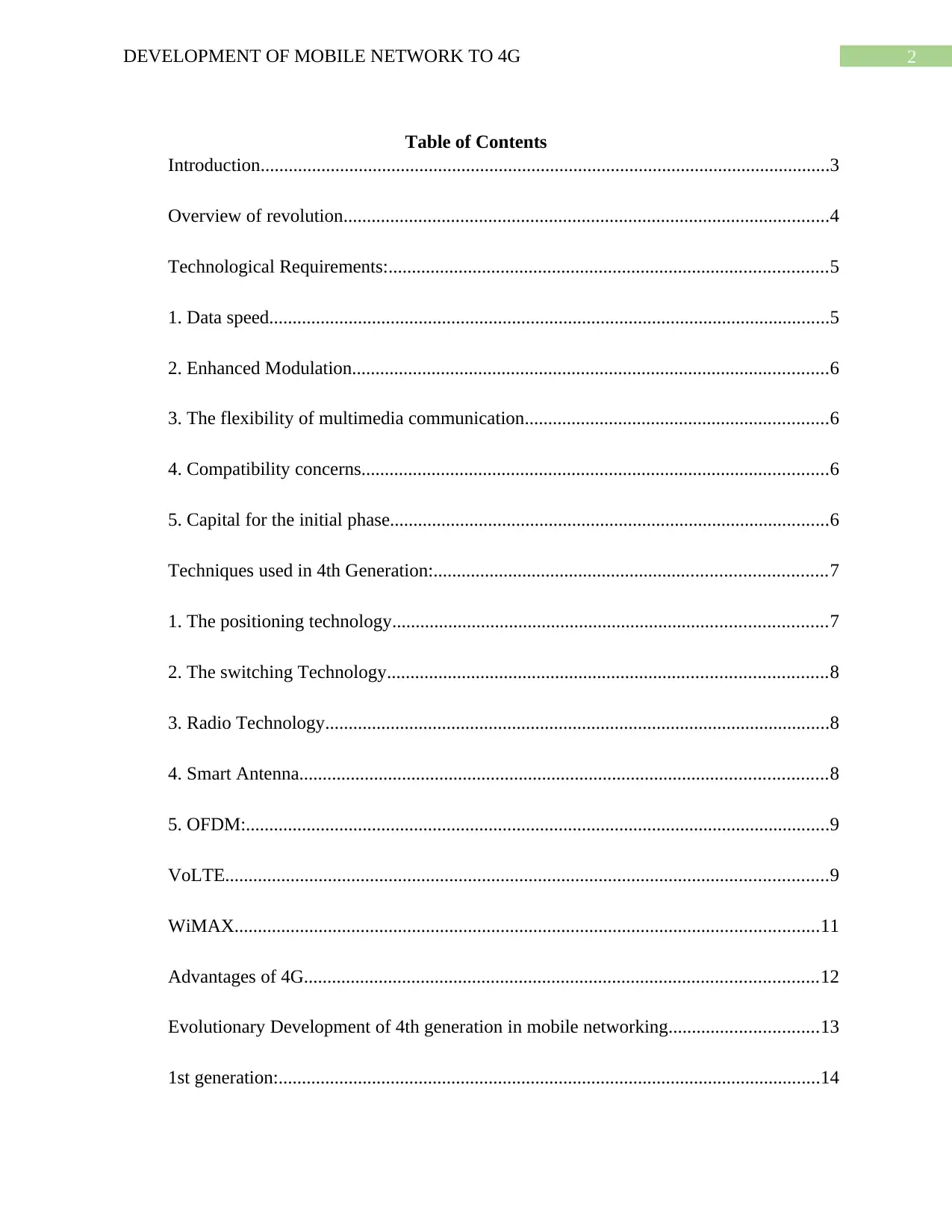
2DEVELOPMENT OF MOBILE NETWORK TO 4G
Table of Contents
Introduction..........................................................................................................................3
Overview of revolution........................................................................................................4
Technological Requirements:..............................................................................................5
1. Data speed........................................................................................................................5
2. Enhanced Modulation......................................................................................................6
3. The flexibility of multimedia communication.................................................................6
4. Compatibility concerns....................................................................................................6
5. Capital for the initial phase..............................................................................................6
Techniques used in 4th Generation:....................................................................................7
1. The positioning technology.............................................................................................7
2. The switching Technology..............................................................................................8
3. Radio Technology............................................................................................................8
4. Smart Antenna.................................................................................................................8
5. OFDM:.............................................................................................................................9
VoLTE.................................................................................................................................9
WiMAX.............................................................................................................................11
Advantages of 4G..............................................................................................................12
Evolutionary Development of 4th generation in mobile networking................................13
1st generation:....................................................................................................................14
Table of Contents
Introduction..........................................................................................................................3
Overview of revolution........................................................................................................4
Technological Requirements:..............................................................................................5
1. Data speed........................................................................................................................5
2. Enhanced Modulation......................................................................................................6
3. The flexibility of multimedia communication.................................................................6
4. Compatibility concerns....................................................................................................6
5. Capital for the initial phase..............................................................................................6
Techniques used in 4th Generation:....................................................................................7
1. The positioning technology.............................................................................................7
2. The switching Technology..............................................................................................8
3. Radio Technology............................................................................................................8
4. Smart Antenna.................................................................................................................8
5. OFDM:.............................................................................................................................9
VoLTE.................................................................................................................................9
WiMAX.............................................................................................................................11
Advantages of 4G..............................................................................................................12
Evolutionary Development of 4th generation in mobile networking................................13
1st generation:....................................................................................................................14
⊘ This is a preview!⊘
Do you want full access?
Subscribe today to unlock all pages.

Trusted by 1+ million students worldwide
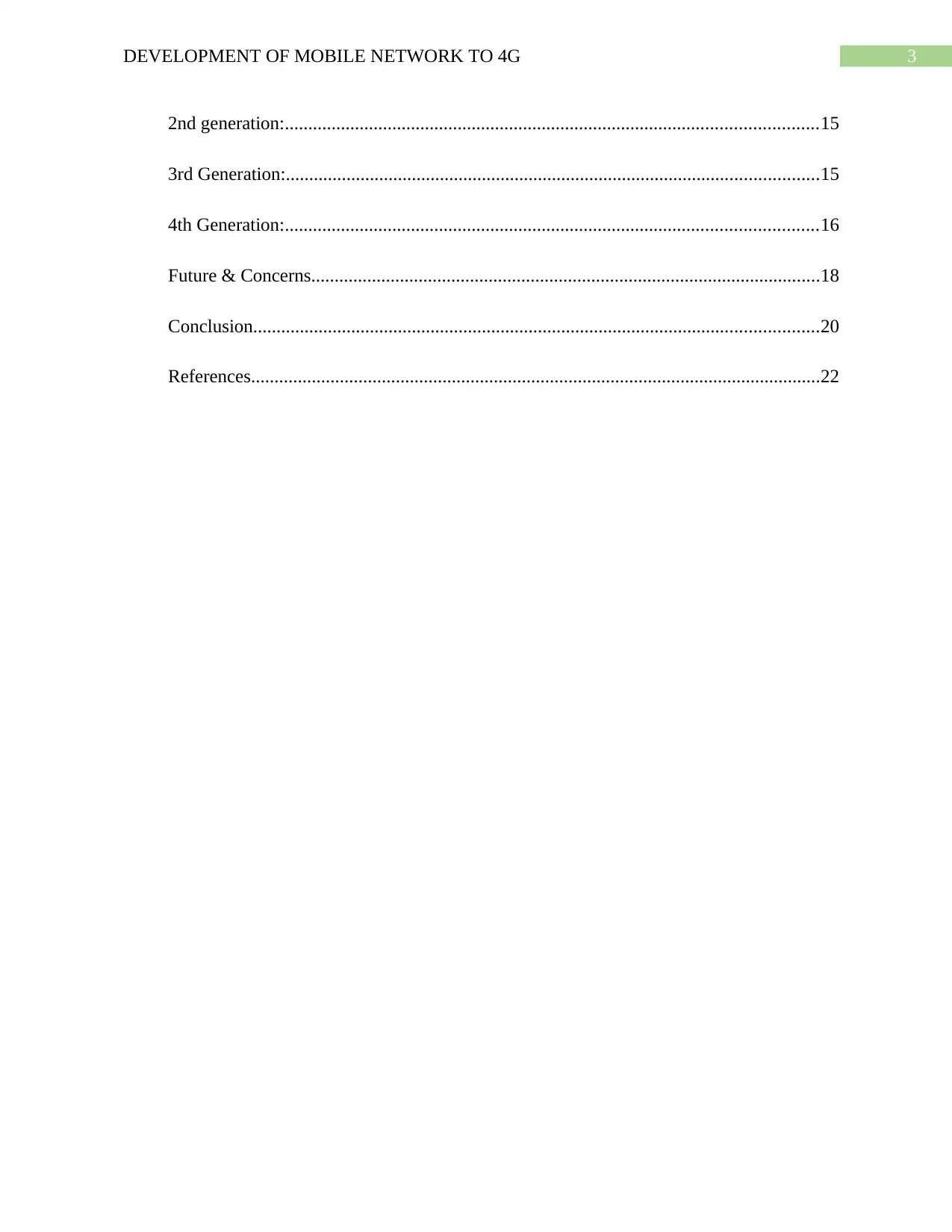
3DEVELOPMENT OF MOBILE NETWORK TO 4G
2nd generation:..................................................................................................................15
3rd Generation:..................................................................................................................15
4th Generation:..................................................................................................................16
Future & Concerns.............................................................................................................18
Conclusion.........................................................................................................................20
References..........................................................................................................................22
2nd generation:..................................................................................................................15
3rd Generation:..................................................................................................................15
4th Generation:..................................................................................................................16
Future & Concerns.............................................................................................................18
Conclusion.........................................................................................................................20
References..........................................................................................................................22
Paraphrase This Document
Need a fresh take? Get an instant paraphrase of this document with our AI Paraphraser
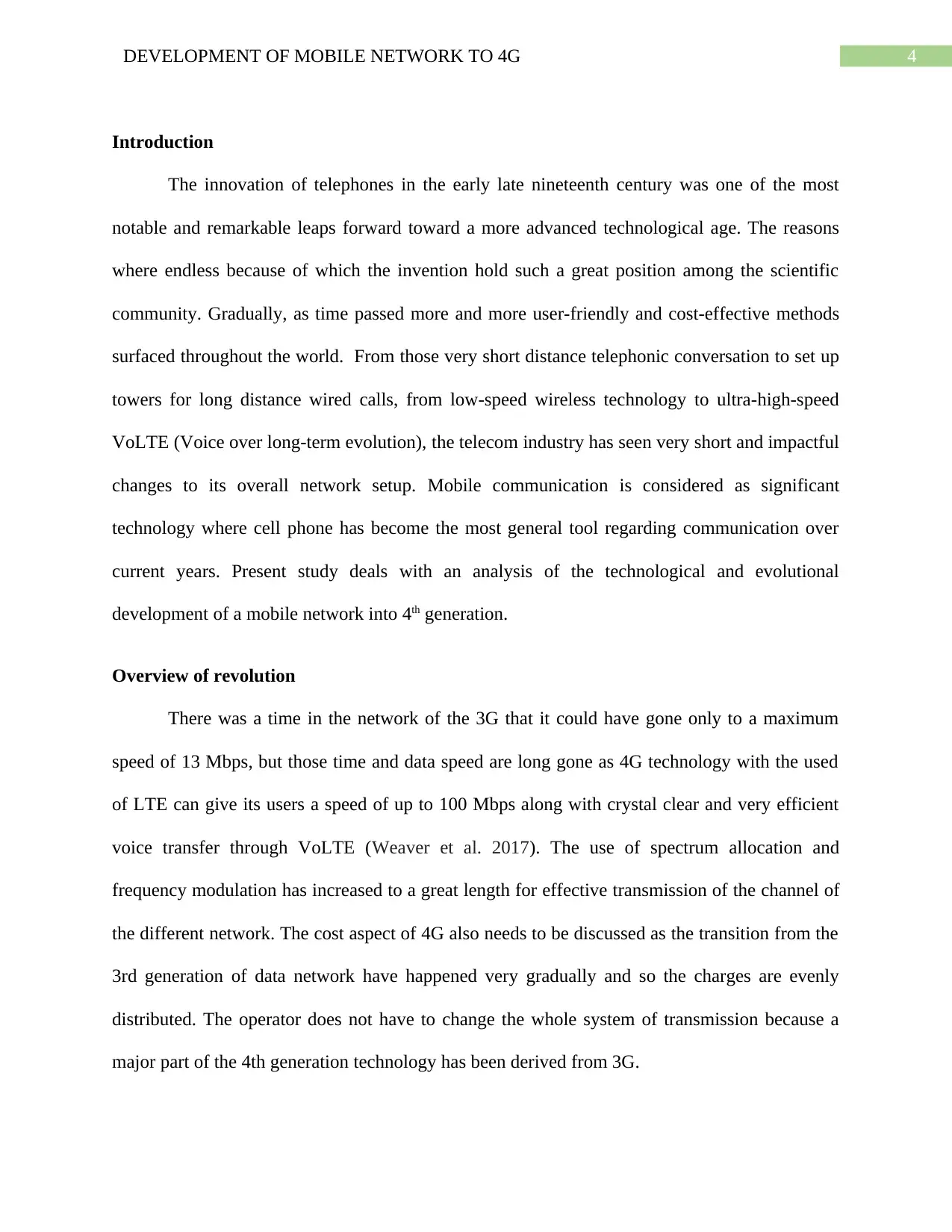
4DEVELOPMENT OF MOBILE NETWORK TO 4G
Introduction
The innovation of telephones in the early late nineteenth century was one of the most
notable and remarkable leaps forward toward a more advanced technological age. The reasons
where endless because of which the invention hold such a great position among the scientific
community. Gradually, as time passed more and more user-friendly and cost-effective methods
surfaced throughout the world. From those very short distance telephonic conversation to set up
towers for long distance wired calls, from low-speed wireless technology to ultra-high-speed
VoLTE (Voice over long-term evolution), the telecom industry has seen very short and impactful
changes to its overall network setup. Mobile communication is considered as significant
technology where cell phone has become the most general tool regarding communication over
current years. Present study deals with an analysis of the technological and evolutional
development of a mobile network into 4th generation.
Overview of revolution
There was a time in the network of the 3G that it could have gone only to a maximum
speed of 13 Mbps, but those time and data speed are long gone as 4G technology with the used
of LTE can give its users a speed of up to 100 Mbps along with crystal clear and very efficient
voice transfer through VoLTE (Weaver et al. 2017). The use of spectrum allocation and
frequency modulation has increased to a great length for effective transmission of the channel of
the different network. The cost aspect of 4G also needs to be discussed as the transition from the
3rd generation of data network have happened very gradually and so the charges are evenly
distributed. The operator does not have to change the whole system of transmission because a
major part of the 4th generation technology has been derived from 3G.
Introduction
The innovation of telephones in the early late nineteenth century was one of the most
notable and remarkable leaps forward toward a more advanced technological age. The reasons
where endless because of which the invention hold such a great position among the scientific
community. Gradually, as time passed more and more user-friendly and cost-effective methods
surfaced throughout the world. From those very short distance telephonic conversation to set up
towers for long distance wired calls, from low-speed wireless technology to ultra-high-speed
VoLTE (Voice over long-term evolution), the telecom industry has seen very short and impactful
changes to its overall network setup. Mobile communication is considered as significant
technology where cell phone has become the most general tool regarding communication over
current years. Present study deals with an analysis of the technological and evolutional
development of a mobile network into 4th generation.
Overview of revolution
There was a time in the network of the 3G that it could have gone only to a maximum
speed of 13 Mbps, but those time and data speed are long gone as 4G technology with the used
of LTE can give its users a speed of up to 100 Mbps along with crystal clear and very efficient
voice transfer through VoLTE (Weaver et al. 2017). The use of spectrum allocation and
frequency modulation has increased to a great length for effective transmission of the channel of
the different network. The cost aspect of 4G also needs to be discussed as the transition from the
3rd generation of data network have happened very gradually and so the charges are evenly
distributed. The operator does not have to change the whole system of transmission because a
major part of the 4th generation technology has been derived from 3G.
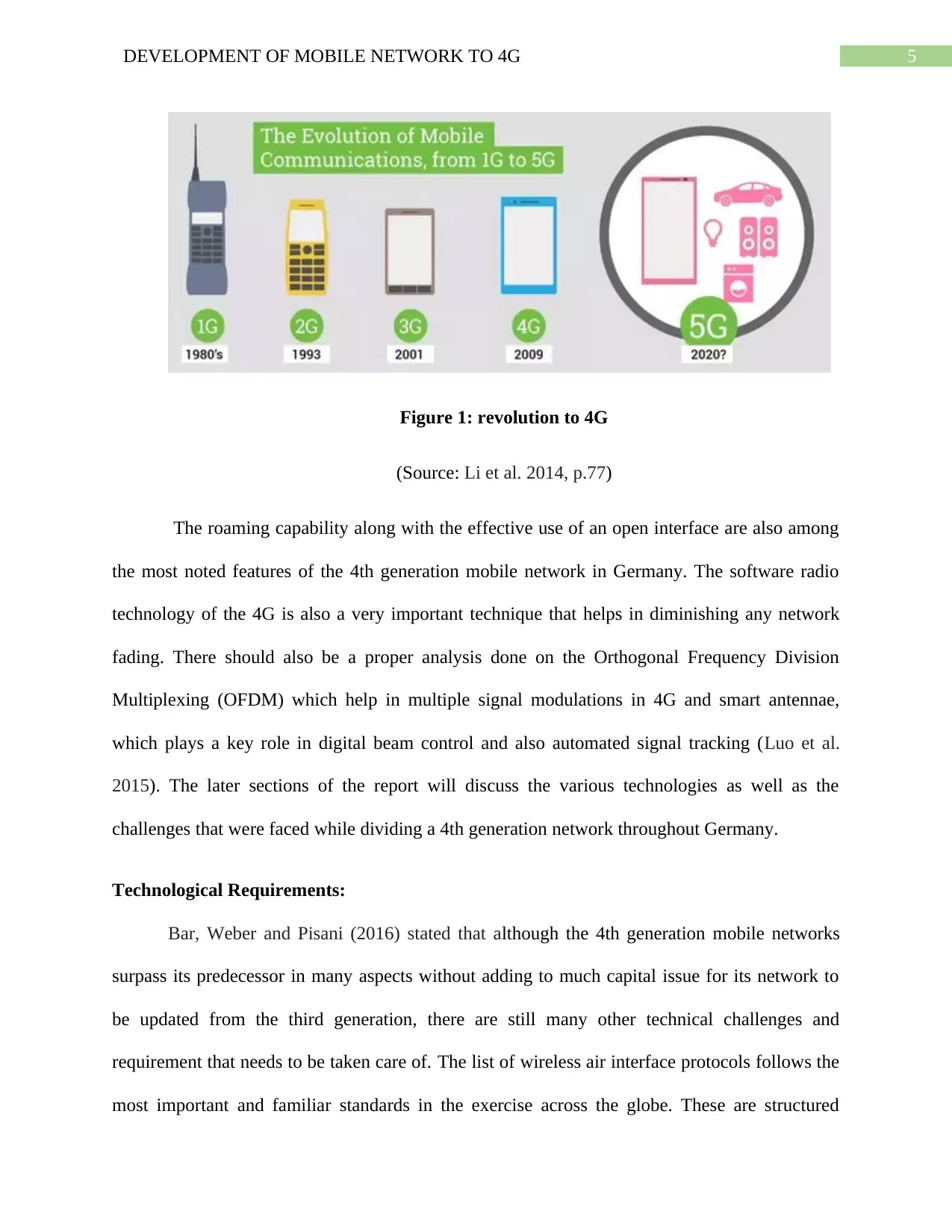
5DEVELOPMENT OF MOBILE NETWORK TO 4G
Figure 1: revolution to 4G
(Source: Li et al. 2014, p.77)
The roaming capability along with the effective use of an open interface are also among
the most noted features of the 4th generation mobile network in Germany. The software radio
technology of the 4G is also a very important technique that helps in diminishing any network
fading. There should also be a proper analysis done on the Orthogonal Frequency Division
Multiplexing (OFDM) which help in multiple signal modulations in 4G and smart antennae,
which plays a key role in digital beam control and also automated signal tracking (Luo et al.
2015). The later sections of the report will discuss the various technologies as well as the
challenges that were faced while dividing a 4th generation network throughout Germany.
Technological Requirements:
Bar, Weber and Pisani (2016) stated that although the 4th generation mobile networks
surpass its predecessor in many aspects without adding to much capital issue for its network to
be updated from the third generation, there are still many other technical challenges and
requirement that needs to be taken care of. The list of wireless air interface protocols follows the
most important and familiar standards in the exercise across the globe. These are structured
Figure 1: revolution to 4G
(Source: Li et al. 2014, p.77)
The roaming capability along with the effective use of an open interface are also among
the most noted features of the 4th generation mobile network in Germany. The software radio
technology of the 4G is also a very important technique that helps in diminishing any network
fading. There should also be a proper analysis done on the Orthogonal Frequency Division
Multiplexing (OFDM) which help in multiple signal modulations in 4G and smart antennae,
which plays a key role in digital beam control and also automated signal tracking (Luo et al.
2015). The later sections of the report will discuss the various technologies as well as the
challenges that were faced while dividing a 4th generation network throughout Germany.
Technological Requirements:
Bar, Weber and Pisani (2016) stated that although the 4th generation mobile networks
surpass its predecessor in many aspects without adding to much capital issue for its network to
be updated from the third generation, there are still many other technical challenges and
requirement that needs to be taken care of. The list of wireless air interface protocols follows the
most important and familiar standards in the exercise across the globe. These are structured
⊘ This is a preview!⊘
Do you want full access?
Subscribe today to unlock all pages.

Trusted by 1+ million students worldwide
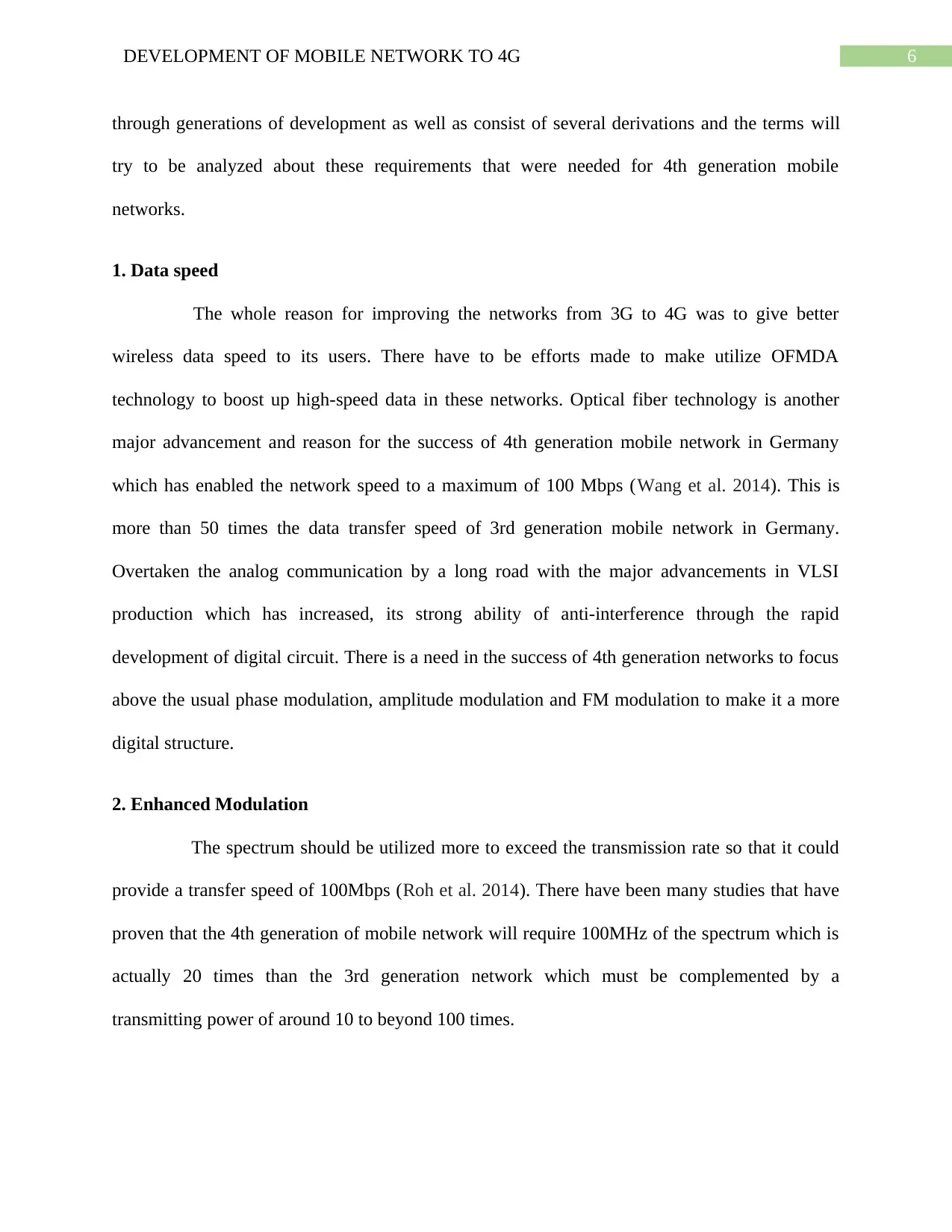
6DEVELOPMENT OF MOBILE NETWORK TO 4G
through generations of development as well as consist of several derivations and the terms will
try to be analyzed about these requirements that were needed for 4th generation mobile
networks.
1. Data speed
The whole reason for improving the networks from 3G to 4G was to give better
wireless data speed to its users. There have to be efforts made to make utilize OFMDA
technology to boost up high-speed data in these networks. Optical fiber technology is another
major advancement and reason for the success of 4th generation mobile network in Germany
which has enabled the network speed to a maximum of 100 Mbps (Wang et al. 2014). This is
more than 50 times the data transfer speed of 3rd generation mobile network in Germany.
Overtaken the analog communication by a long road with the major advancements in VLSI
production which has increased, its strong ability of anti-interference through the rapid
development of digital circuit. There is a need in the success of 4th generation networks to focus
above the usual phase modulation, amplitude modulation and FM modulation to make it a more
digital structure.
2. Enhanced Modulation
The spectrum should be utilized more to exceed the transmission rate so that it could
provide a transfer speed of 100Mbps (Roh et al. 2014). There have been many studies that have
proven that the 4th generation of mobile network will require 100MHz of the spectrum which is
actually 20 times than the 3rd generation network which must be complemented by a
transmitting power of around 10 to beyond 100 times.
through generations of development as well as consist of several derivations and the terms will
try to be analyzed about these requirements that were needed for 4th generation mobile
networks.
1. Data speed
The whole reason for improving the networks from 3G to 4G was to give better
wireless data speed to its users. There have to be efforts made to make utilize OFMDA
technology to boost up high-speed data in these networks. Optical fiber technology is another
major advancement and reason for the success of 4th generation mobile network in Germany
which has enabled the network speed to a maximum of 100 Mbps (Wang et al. 2014). This is
more than 50 times the data transfer speed of 3rd generation mobile network in Germany.
Overtaken the analog communication by a long road with the major advancements in VLSI
production which has increased, its strong ability of anti-interference through the rapid
development of digital circuit. There is a need in the success of 4th generation networks to focus
above the usual phase modulation, amplitude modulation and FM modulation to make it a more
digital structure.
2. Enhanced Modulation
The spectrum should be utilized more to exceed the transmission rate so that it could
provide a transfer speed of 100Mbps (Roh et al. 2014). There have been many studies that have
proven that the 4th generation of mobile network will require 100MHz of the spectrum which is
actually 20 times than the 3rd generation network which must be complemented by a
transmitting power of around 10 to beyond 100 times.
Paraphrase This Document
Need a fresh take? Get an instant paraphrase of this document with our AI Paraphraser
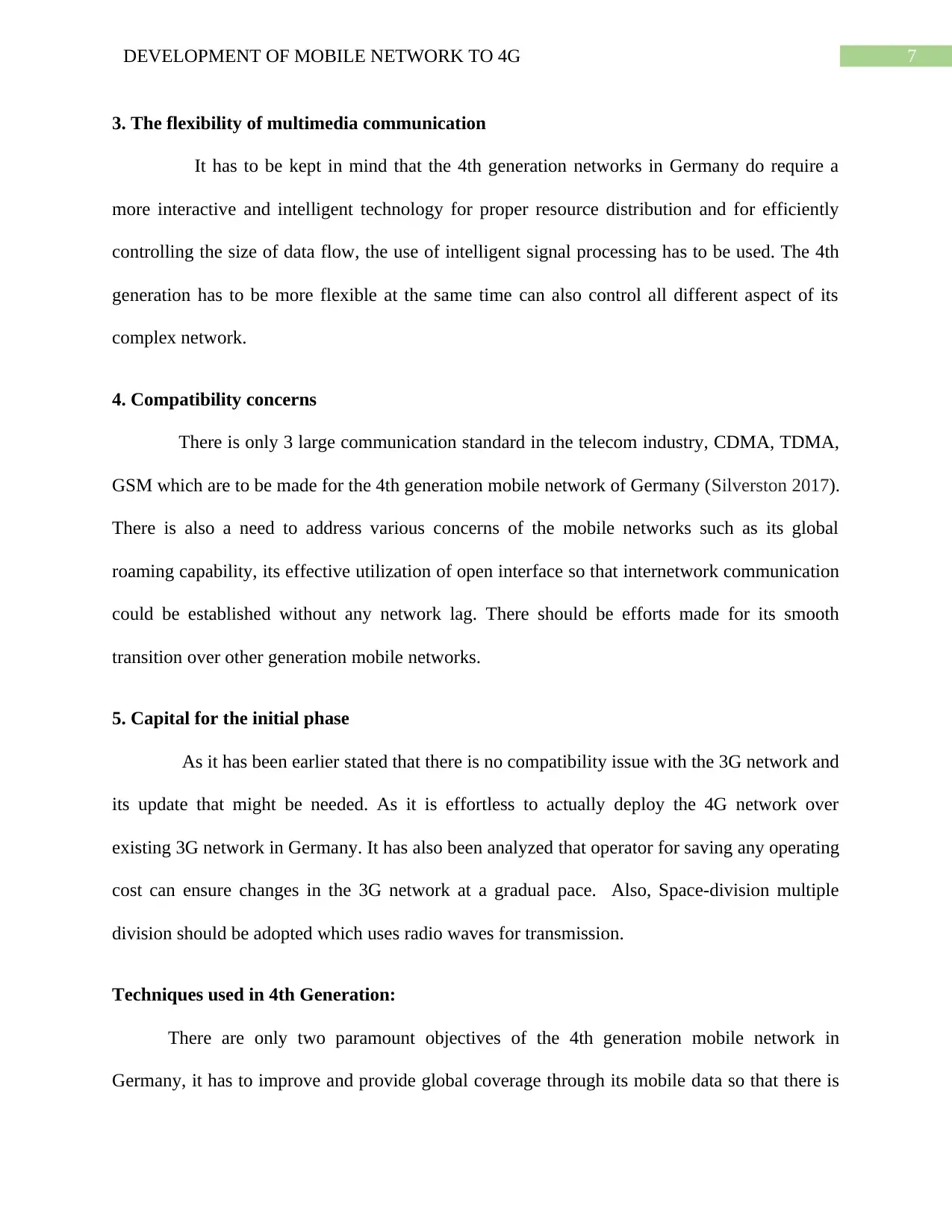
7DEVELOPMENT OF MOBILE NETWORK TO 4G
3. The flexibility of multimedia communication
It has to be kept in mind that the 4th generation networks in Germany do require a
more interactive and intelligent technology for proper resource distribution and for efficiently
controlling the size of data flow, the use of intelligent signal processing has to be used. The 4th
generation has to be more flexible at the same time can also control all different aspect of its
complex network.
4. Compatibility concerns
There is only 3 large communication standard in the telecom industry, CDMA, TDMA,
GSM which are to be made for the 4th generation mobile network of Germany (Silverston 2017).
There is also a need to address various concerns of the mobile networks such as its global
roaming capability, its effective utilization of open interface so that internetwork communication
could be established without any network lag. There should be efforts made for its smooth
transition over other generation mobile networks.
5. Capital for the initial phase
As it has been earlier stated that there is no compatibility issue with the 3G network and
its update that might be needed. As it is effortless to actually deploy the 4G network over
existing 3G network in Germany. It has also been analyzed that operator for saving any operating
cost can ensure changes in the 3G network at a gradual pace. Also, Space-division multiple
division should be adopted which uses radio waves for transmission.
Techniques used in 4th Generation:
There are only two paramount objectives of the 4th generation mobile network in
Germany, it has to improve and provide global coverage through its mobile data so that there is
3. The flexibility of multimedia communication
It has to be kept in mind that the 4th generation networks in Germany do require a
more interactive and intelligent technology for proper resource distribution and for efficiently
controlling the size of data flow, the use of intelligent signal processing has to be used. The 4th
generation has to be more flexible at the same time can also control all different aspect of its
complex network.
4. Compatibility concerns
There is only 3 large communication standard in the telecom industry, CDMA, TDMA,
GSM which are to be made for the 4th generation mobile network of Germany (Silverston 2017).
There is also a need to address various concerns of the mobile networks such as its global
roaming capability, its effective utilization of open interface so that internetwork communication
could be established without any network lag. There should be efforts made for its smooth
transition over other generation mobile networks.
5. Capital for the initial phase
As it has been earlier stated that there is no compatibility issue with the 3G network and
its update that might be needed. As it is effortless to actually deploy the 4G network over
existing 3G network in Germany. It has also been analyzed that operator for saving any operating
cost can ensure changes in the 3G network at a gradual pace. Also, Space-division multiple
division should be adopted which uses radio waves for transmission.
Techniques used in 4th Generation:
There are only two paramount objectives of the 4th generation mobile network in
Germany, it has to improve and provide global coverage through its mobile data so that there is
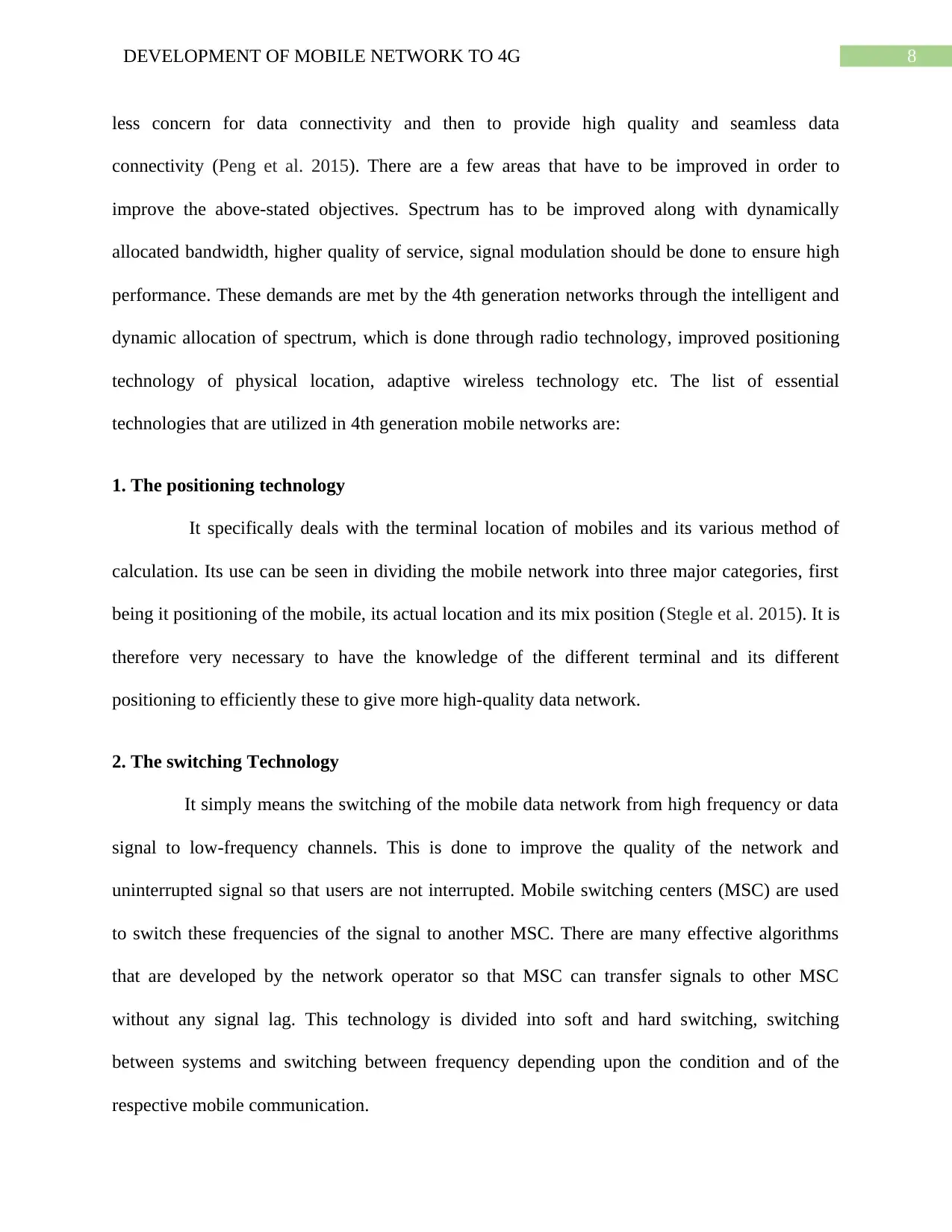
8DEVELOPMENT OF MOBILE NETWORK TO 4G
less concern for data connectivity and then to provide high quality and seamless data
connectivity (Peng et al. 2015). There are a few areas that have to be improved in order to
improve the above-stated objectives. Spectrum has to be improved along with dynamically
allocated bandwidth, higher quality of service, signal modulation should be done to ensure high
performance. These demands are met by the 4th generation networks through the intelligent and
dynamic allocation of spectrum, which is done through radio technology, improved positioning
technology of physical location, adaptive wireless technology etc. The list of essential
technologies that are utilized in 4th generation mobile networks are:
1. The positioning technology
It specifically deals with the terminal location of mobiles and its various method of
calculation. Its use can be seen in dividing the mobile network into three major categories, first
being it positioning of the mobile, its actual location and its mix position (Stegle et al. 2015). It is
therefore very necessary to have the knowledge of the different terminal and its different
positioning to efficiently these to give more high-quality data network.
2. The switching Technology
It simply means the switching of the mobile data network from high frequency or data
signal to low-frequency channels. This is done to improve the quality of the network and
uninterrupted signal so that users are not interrupted. Mobile switching centers (MSC) are used
to switch these frequencies of the signal to another MSC. There are many effective algorithms
that are developed by the network operator so that MSC can transfer signals to other MSC
without any signal lag. This technology is divided into soft and hard switching, switching
between systems and switching between frequency depending upon the condition and of the
respective mobile communication.
less concern for data connectivity and then to provide high quality and seamless data
connectivity (Peng et al. 2015). There are a few areas that have to be improved in order to
improve the above-stated objectives. Spectrum has to be improved along with dynamically
allocated bandwidth, higher quality of service, signal modulation should be done to ensure high
performance. These demands are met by the 4th generation networks through the intelligent and
dynamic allocation of spectrum, which is done through radio technology, improved positioning
technology of physical location, adaptive wireless technology etc. The list of essential
technologies that are utilized in 4th generation mobile networks are:
1. The positioning technology
It specifically deals with the terminal location of mobiles and its various method of
calculation. Its use can be seen in dividing the mobile network into three major categories, first
being it positioning of the mobile, its actual location and its mix position (Stegle et al. 2015). It is
therefore very necessary to have the knowledge of the different terminal and its different
positioning to efficiently these to give more high-quality data network.
2. The switching Technology
It simply means the switching of the mobile data network from high frequency or data
signal to low-frequency channels. This is done to improve the quality of the network and
uninterrupted signal so that users are not interrupted. Mobile switching centers (MSC) are used
to switch these frequencies of the signal to another MSC. There are many effective algorithms
that are developed by the network operator so that MSC can transfer signals to other MSC
without any signal lag. This technology is divided into soft and hard switching, switching
between systems and switching between frequency depending upon the condition and of the
respective mobile communication.
⊘ This is a preview!⊘
Do you want full access?
Subscribe today to unlock all pages.

Trusted by 1+ million students worldwide
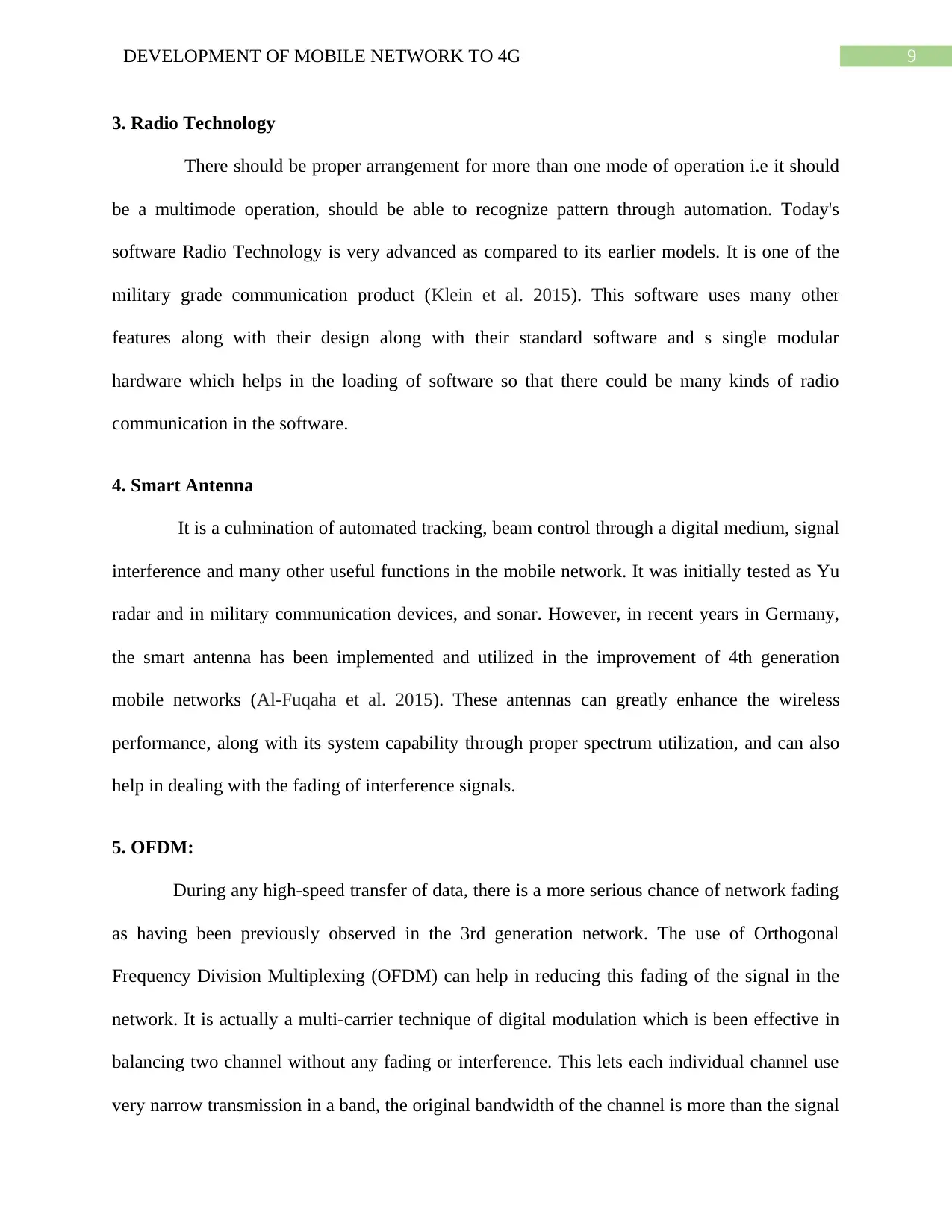
9DEVELOPMENT OF MOBILE NETWORK TO 4G
3. Radio Technology
There should be proper arrangement for more than one mode of operation i.e it should
be a multimode operation, should be able to recognize pattern through automation. Today's
software Radio Technology is very advanced as compared to its earlier models. It is one of the
military grade communication product (Klein et al. 2015). This software uses many other
features along with their design along with their standard software and s single modular
hardware which helps in the loading of software so that there could be many kinds of radio
communication in the software.
4. Smart Antenna
It is a culmination of automated tracking, beam control through a digital medium, signal
interference and many other useful functions in the mobile network. It was initially tested as Yu
radar and in military communication devices, and sonar. However, in recent years in Germany,
the smart antenna has been implemented and utilized in the improvement of 4th generation
mobile networks (Al-Fuqaha et al. 2015). These antennas can greatly enhance the wireless
performance, along with its system capability through proper spectrum utilization, and can also
help in dealing with the fading of interference signals.
5. OFDM:
During any high-speed transfer of data, there is a more serious chance of network fading
as having been previously observed in the 3rd generation network. The use of Orthogonal
Frequency Division Multiplexing (OFDM) can help in reducing this fading of the signal in the
network. It is actually a multi-carrier technique of digital modulation which is been effective in
balancing two channel without any fading or interference. This lets each individual channel use
very narrow transmission in a band, the original bandwidth of the channel is more than the signal
3. Radio Technology
There should be proper arrangement for more than one mode of operation i.e it should
be a multimode operation, should be able to recognize pattern through automation. Today's
software Radio Technology is very advanced as compared to its earlier models. It is one of the
military grade communication product (Klein et al. 2015). This software uses many other
features along with their design along with their standard software and s single modular
hardware which helps in the loading of software so that there could be many kinds of radio
communication in the software.
4. Smart Antenna
It is a culmination of automated tracking, beam control through a digital medium, signal
interference and many other useful functions in the mobile network. It was initially tested as Yu
radar and in military communication devices, and sonar. However, in recent years in Germany,
the smart antenna has been implemented and utilized in the improvement of 4th generation
mobile networks (Al-Fuqaha et al. 2015). These antennas can greatly enhance the wireless
performance, along with its system capability through proper spectrum utilization, and can also
help in dealing with the fading of interference signals.
5. OFDM:
During any high-speed transfer of data, there is a more serious chance of network fading
as having been previously observed in the 3rd generation network. The use of Orthogonal
Frequency Division Multiplexing (OFDM) can help in reducing this fading of the signal in the
network. It is actually a multi-carrier technique of digital modulation which is been effective in
balancing two channel without any fading or interference. This lets each individual channel use
very narrow transmission in a band, the original bandwidth of the channel is more than the signal
Paraphrase This Document
Need a fresh take? Get an instant paraphrase of this document with our AI Paraphraser
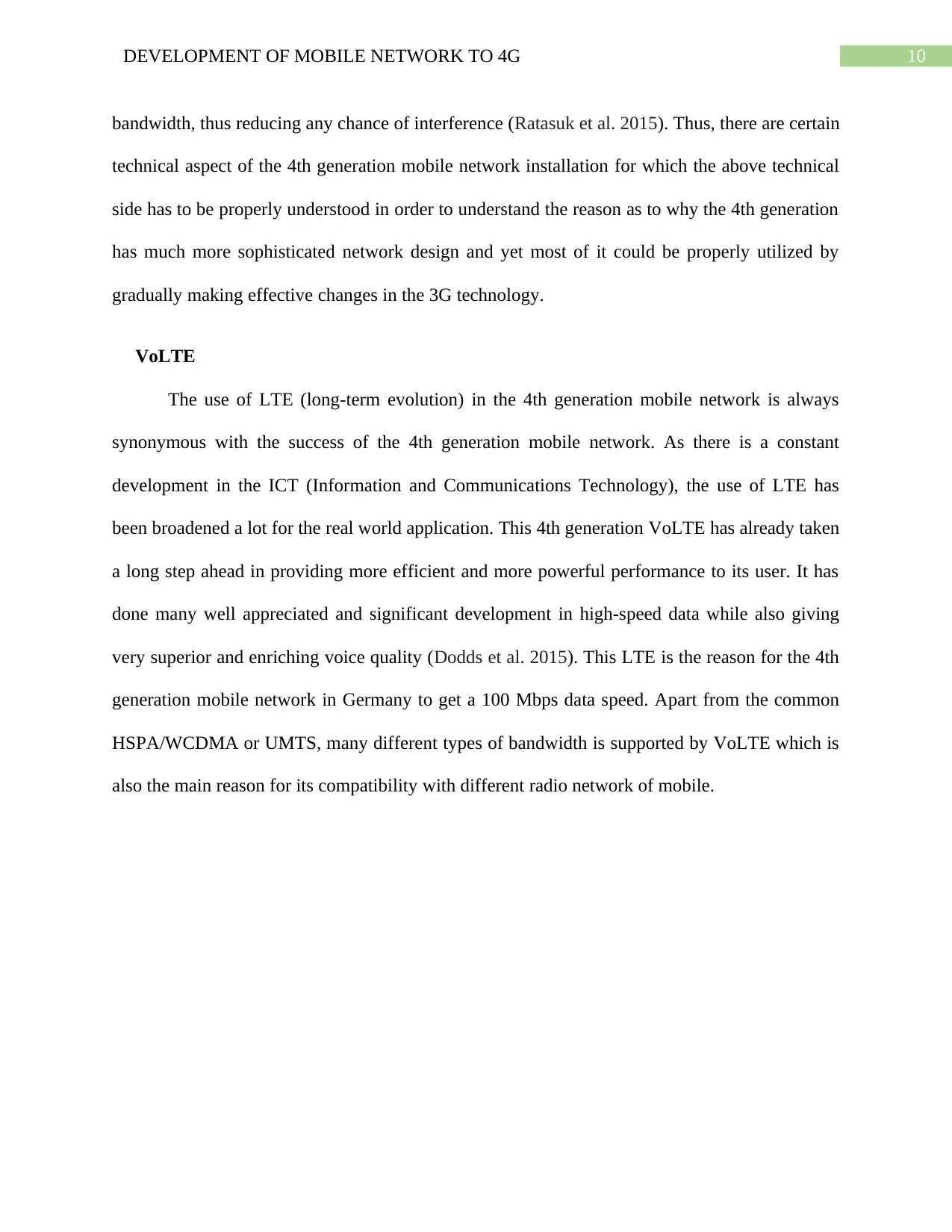
10DEVELOPMENT OF MOBILE NETWORK TO 4G
bandwidth, thus reducing any chance of interference (Ratasuk et al. 2015). Thus, there are certain
technical aspect of the 4th generation mobile network installation for which the above technical
side has to be properly understood in order to understand the reason as to why the 4th generation
has much more sophisticated network design and yet most of it could be properly utilized by
gradually making effective changes in the 3G technology.
VoLTE
The use of LTE (long-term evolution) in the 4th generation mobile network is always
synonymous with the success of the 4th generation mobile network. As there is a constant
development in the ICT (Information and Communications Technology), the use of LTE has
been broadened a lot for the real world application. This 4th generation VoLTE has already taken
a long step ahead in providing more efficient and more powerful performance to its user. It has
done many well appreciated and significant development in high-speed data while also giving
very superior and enriching voice quality (Dodds et al. 2015). This LTE is the reason for the 4th
generation mobile network in Germany to get a 100 Mbps data speed. Apart from the common
HSPA/WCDMA or UMTS, many different types of bandwidth is supported by VoLTE which is
also the main reason for its compatibility with different radio network of mobile.
bandwidth, thus reducing any chance of interference (Ratasuk et al. 2015). Thus, there are certain
technical aspect of the 4th generation mobile network installation for which the above technical
side has to be properly understood in order to understand the reason as to why the 4th generation
has much more sophisticated network design and yet most of it could be properly utilized by
gradually making effective changes in the 3G technology.
VoLTE
The use of LTE (long-term evolution) in the 4th generation mobile network is always
synonymous with the success of the 4th generation mobile network. As there is a constant
development in the ICT (Information and Communications Technology), the use of LTE has
been broadened a lot for the real world application. This 4th generation VoLTE has already taken
a long step ahead in providing more efficient and more powerful performance to its user. It has
done many well appreciated and significant development in high-speed data while also giving
very superior and enriching voice quality (Dodds et al. 2015). This LTE is the reason for the 4th
generation mobile network in Germany to get a 100 Mbps data speed. Apart from the common
HSPA/WCDMA or UMTS, many different types of bandwidth is supported by VoLTE which is
also the main reason for its compatibility with different radio network of mobile.
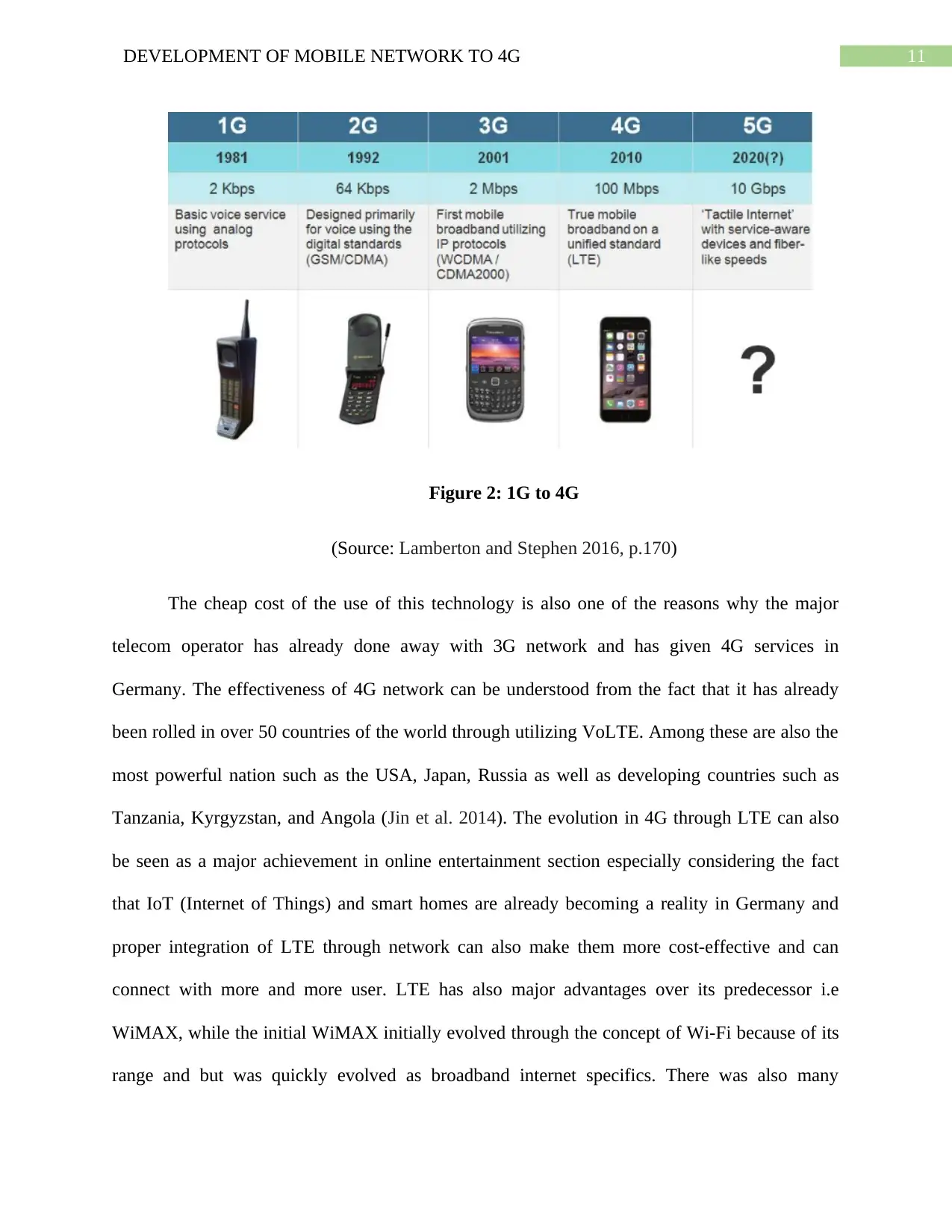
11DEVELOPMENT OF MOBILE NETWORK TO 4G
Figure 2: 1G to 4G
(Source: Lamberton and Stephen 2016, p.170)
The cheap cost of the use of this technology is also one of the reasons why the major
telecom operator has already done away with 3G network and has given 4G services in
Germany. The effectiveness of 4G network can be understood from the fact that it has already
been rolled in over 50 countries of the world through utilizing VoLTE. Among these are also the
most powerful nation such as the USA, Japan, Russia as well as developing countries such as
Tanzania, Kyrgyzstan, and Angola (Jin et al. 2014). The evolution in 4G through LTE can also
be seen as a major achievement in online entertainment section especially considering the fact
that IoT (Internet of Things) and smart homes are already becoming a reality in Germany and
proper integration of LTE through network can also make them more cost-effective and can
connect with more and more user. LTE has also major advantages over its predecessor i.e
WiMAX, while the initial WiMAX initially evolved through the concept of Wi-Fi because of its
range and but was quickly evolved as broadband internet specifics. There was also many
Figure 2: 1G to 4G
(Source: Lamberton and Stephen 2016, p.170)
The cheap cost of the use of this technology is also one of the reasons why the major
telecom operator has already done away with 3G network and has given 4G services in
Germany. The effectiveness of 4G network can be understood from the fact that it has already
been rolled in over 50 countries of the world through utilizing VoLTE. Among these are also the
most powerful nation such as the USA, Japan, Russia as well as developing countries such as
Tanzania, Kyrgyzstan, and Angola (Jin et al. 2014). The evolution in 4G through LTE can also
be seen as a major achievement in online entertainment section especially considering the fact
that IoT (Internet of Things) and smart homes are already becoming a reality in Germany and
proper integration of LTE through network can also make them more cost-effective and can
connect with more and more user. LTE has also major advantages over its predecessor i.e
WiMAX, while the initial WiMAX initially evolved through the concept of Wi-Fi because of its
range and but was quickly evolved as broadband internet specifics. There was also many
⊘ This is a preview!⊘
Do you want full access?
Subscribe today to unlock all pages.

Trusted by 1+ million students worldwide
1 out of 30
Related Documents
Your All-in-One AI-Powered Toolkit for Academic Success.
+13062052269
info@desklib.com
Available 24*7 on WhatsApp / Email
![[object Object]](/_next/static/media/star-bottom.7253800d.svg)
Unlock your academic potential
Copyright © 2020–2025 A2Z Services. All Rights Reserved. Developed and managed by ZUCOL.





